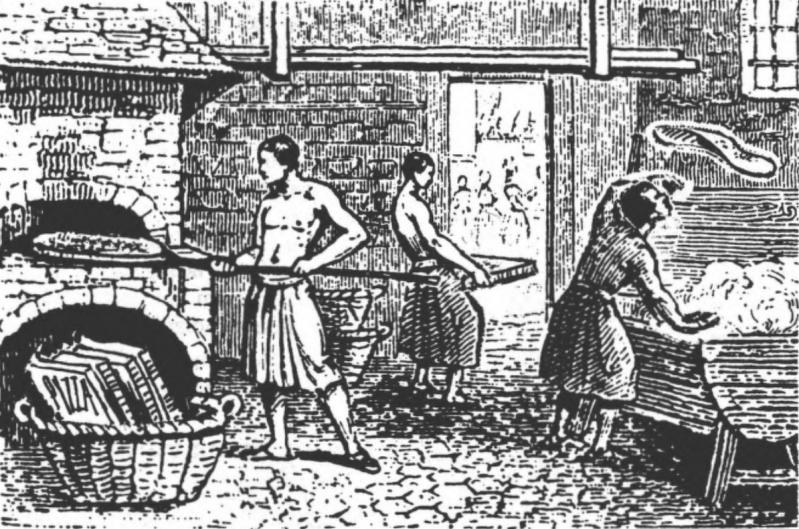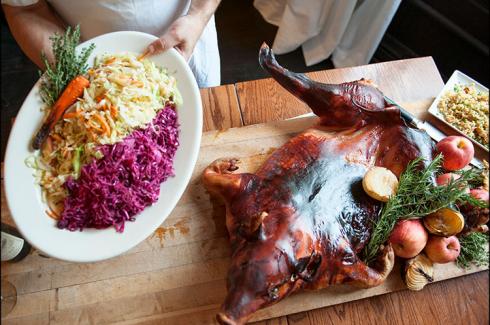The Neapolitan pie, hardly known in this country before the 1930s, must certainly have overtaken the hot dog as the nation’s number one favorite snack food. According to scholarly research conducted in the ’50s by the lat Richard Gehman, one Frank Mastro from Bari (not Naples) is credited with popularizing pizza outside the Italian neighborhoods in New York.
Mr. Mastro, the first Pizza King, also convinced the handful of pizzaiulos (pizza bakers) around the City that a great pizza could only be baked in a coal oven (I saw an old pizzeria on Houston Street recently that still boasts on an outside sign “Coal Oven Pizzas”). If Mr. Mastro could only see what he has wrought: The focal spot of every glitzy new restaurant in Manhattan is enormous wood-burning pizza ovens with peel-wielding chefs hauling pizzas in and out day and night. And in place of the basic “plain” pizza — tomato sauce, mozzarella, oregano, olive oil, and Parmesan — everything from smoked salmon with caviar to exotic wild mushrooms.
The sky’s the limit. But then pizza’s always lent itself to the zanier imaginings of the burgeoning contemporary pizzaiulos, including Austrian-born Wolfgang Puck, master of Spago, the famous Hollywood pizzeria. (That definition probably isn’t fair, but the night I was there I saw nothing but pizzas on my own and nearby tables.)
Peasant Food
Mr. Gehman sought out Frank the King’s son Vincent, who designs and sells pizza ovens — gas-burning; it turned out that coal got the ovens no hotter than gas. Vincent, explaining the phenomenal growth of the pizza business (in the ’50s), said, “Pizza is peasant food — a 65-cent pie costs only 20 or 25 cents to make and profits are high.” Ah, Vincent, Vincent, what must the profits be now that the humblest pie goes for about six bucks with nothing on it but a little “mutzerell?” At most of the traditional pizzerias each “extra,” such as mushrooms, anchovies, sausage, or peppers, costs another dollar. Even children under five demand at least one “extra.” Heaven only knows what the legendary pizza eater Jackie Gleason built his tab to ordering his pies “loaded,” three at a sitting.
Now that this “peasant food” has risen meteorically into the world of fashion, the newly glamorous pizza decked out in goat cheese and sundried tomatoes or gorgonzola and prosciutto can easily go for $8 or $10 for a little eight-inch “pizzette.” I never cottoned much to this Neapolitan delight so beloved by Americans of every cultural background. About one a year was my limit—until I learned to make it myself. Now I am smitten but still too rigid to think that any good can come of putting smoked salmon and caviar on searing melted cheese. But I did fall for the gorgonzola and prosciutto partnership at a Manhattan restaurant called Orso’s. The wood-fired ovens at Prima Donna, another Manhattan establishment, produce crisply thin pizzettes, my favorite the one topped with four varieties of fragrant wild mushrooms.
Although perhaps it does lend a slightly smoky taste, it is not in the least necessary to have a wood-fired oven and anyone with a stove that heats to 475 or 500 degrees Fahrenheit can make a pizza. Pizzas must be quickly baked on the lowest rack or even the floor of the oven. I line my lowest rack with quarry tiles (which later can be plopped in the dishwasher) and slide my pizzas onto them when the tiles are smoking hot, using a baker’s peel. Again, though, you can arrange the dough in either a round or an oval or an oblong on a heavy baking sheet (one that won’t buckle at this heat). The dough is simple and can be made by hand or in just a few seconds in a processor.
August Pizza
With all the season’s aromatic herbs and lush vegetables at hand, here’s my rustic version of pizza. You can buy frozen pizza dough in supermarkets, but it’s simple enough to make your own.
Basic Yeast Dough
2 packages active dry yeast
1 cup warm water (110 degrees)
3 1/2 cups unbleached white flour (approx.)
2 tsp. salt
1/4 cup olive oil
Mix the yeast with half of the water and a tablespoon of the flour. It should begin to “work,” which proves the yeast is live, after about five minutes on a warm day. Put the flour and salt in the work bowl of a processor and pulse it a few times. Then add the yeast mixture, the rest of the warm water, and the oil. Pulse the machine several times until the ingredients are mixed. Then let it run continuously until the dough rides the blades. If it’s too sticky, add a bit more flour, if too dry a few drops of water. Remove and knead the dough by hand for a minute or so on a marble top or floured board. Put it into an oiled bowl and turn it over to oil it all round. Cover with a dampened tea towel and leave to rise in a warm place for about an hour or until doubled in bulk. Punch it down and set it to rise again. If you will not be using all the dough, divide it after the first rising and put it into a plastic bag, tying it securely. You can store it in the fridge a couple of days or wrap it tightly and freeze it for later use.
Preheat the oven to 475 degrees for about 30 minutes. If using quarry tiles or a pizza stone, they must be put into the cold oven to heat up slowly.
After the dough rises a second time, divide it for two round 12-inch pizzas or leave it in one piece for a large oblong one. The very large oblong or oval pizza is impressive looking but they are rather hard to manage on a baker’s peel so it is safer to bake them on a heavy metal baking sheet. Roll out the dough as well as you can, then use your fists to lift it up and stretch it until it is only about one-fourth inch thick. Put it on the peel or in your pizza pan and make a rim so the filling will not run over the edges. Make little dents in the dough with your index and middle knuckles. Dribble the dough with some olive oil or paint it on with a brush.
Pizza Filling
These quantities are for a single pizza. Double them if you are making two or a very large single one.
6 ozs. fontina cheese, coarsely shredded
2 cups onions, thinly sliced and sautéed in oil
2 cloves garlic, minced
4 baby eggplants, sliced into fans or long thin slices, briefly sautéed in olive oil
2 medium-size ripe meaty tomatoes, sliced
1 small tin flat anchovy fillets, drained
Salt and coarsely ground black pepper
1 Tbsp. basil leaves, minced
1 Tbsp. marjoram leaves, minced
Sprinkle the cheese over the dough. Spread the onions and garlic over this. Then arrange the eggplant in a symmetrical pattern, then the tomato slices, and insert the anchovy fillets in a spoke pattern between the other ingredients. Salt and pepper the top and slide the pizza into the preheated oven. Bake about ten minutes or until edges are crisp and golden. Sprinkle at once with the minced herbs and let the pizza sit a few minutes before attempting to cut it either with a pizza wheel or long, thin, strong shears (these used to be found around newspaper offices but maybe editing shears are an anachronism in the computer age).
Pizza can be cut with a kitchen knife but it’s a messy business. I often add stoned, halved Greek or Italian cured olives to this group of ingredients. Pizza is fun to make and popular with just about everyone; it’s good summer food despite the fact that one must heat up the oven. Pizza bakes in such a short time, it doesn’t keep you in the kitchen long. Try your hand; let your wildest dreams run rampant — you can put just about any topping on a pizza if it will be cooked in 10 minutes.





